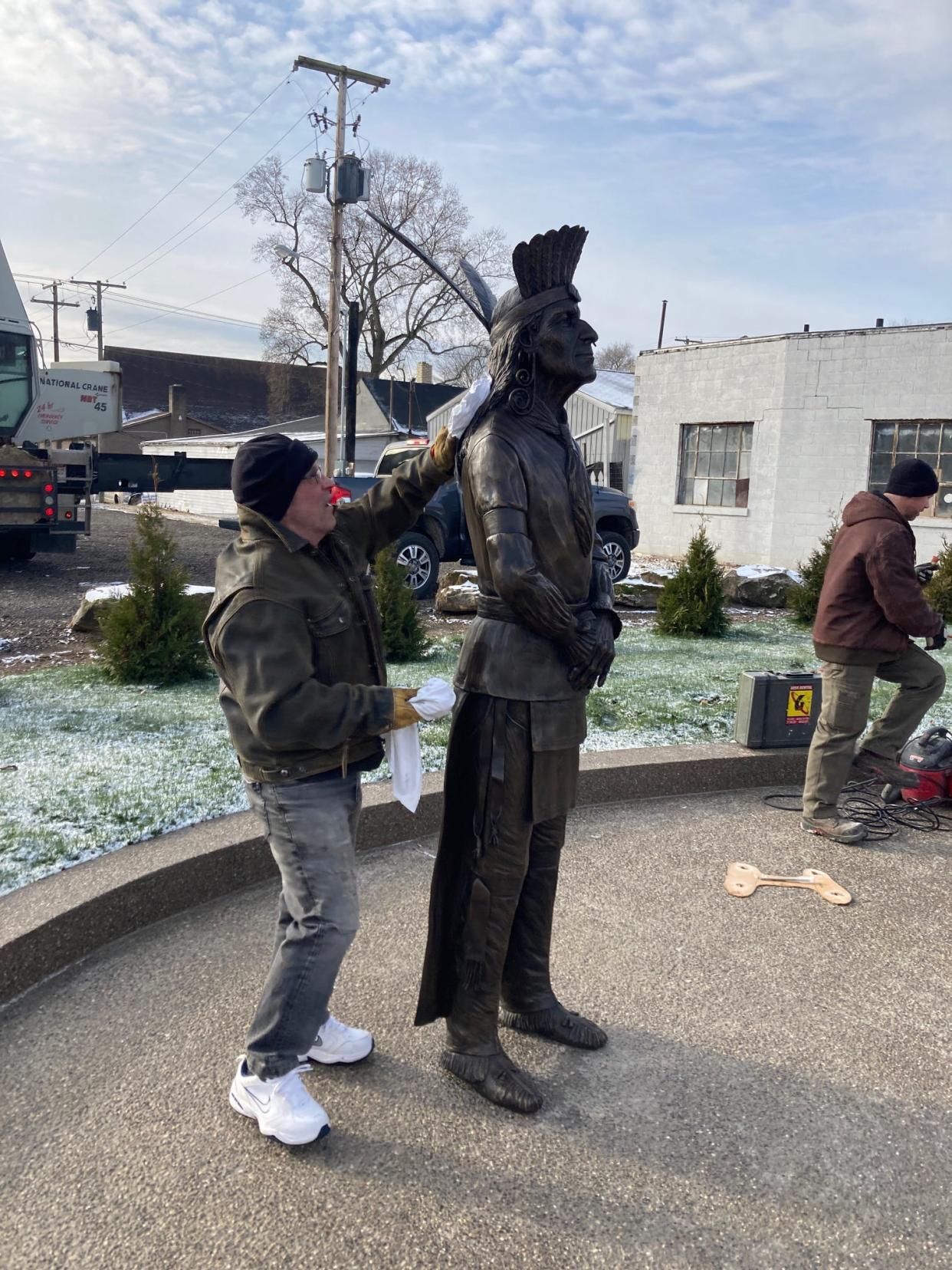Welcome home Wise Counselor: Newcomerstown statue honors Chief Netawatwees

NEWCOMERSTOWN ‒ The Wise Counselor has returned to the village.
Chief Netawatwees, known as the Wise Counselor during his time as head of the Lenape Indian tribe, has been immortalized as a bronze statue outside the Temperance Tavern Museum in Newcomerstown, the site of his Indian nation.
The Newcomerstown Historical Society has partnered with renowned sculptor Alan Cottrill to create a Lenape Disapora Memorial of six bronze sculptures to commemorate the Indian nations.
Who is Chief Netawatwees and what are his ties to Newcomerstown?
According to information provided by the Newcomerstown Historical Society, Chief Netawatawees lived from 1686 to 1776 and was head of the Lenape Indians. He was recognized in the region as the head chief of all the Lenape.
He signed many treaties and moved his tribe to Gekelmukpechunk, which was later named Newcomerstown in his honor in eastern Ohio in 1759. He is the chief who invited the Moravian missionary David Zeisberger to establish the Moravian Missions near his village. The elderly chief died at Ft. Pitt during the Revolutionary War while trying to facilitate peace between the Lenape and the Americans.
Netawatawees is in a pose representative of his “wise counselor” moniker.
Cottrill can trace his ancestry back to the Lenape Nation. In announcing his participation in the project earlier, Cottrill said, “I’m a huge student of history and I’m also really big into family and genealogy. It was just four years ago that I discovered my link to Chief Netawatwees. I’ve always been empathetic to the Native American plight throughout history. This represents an historically correct account, not only for this area, but to represent the plight of Indians throughout the United States.”
More recently, Cottrill said he had read 10 books about the era, including books by Russell Booth and information from Russell’s son, Rick Booth, that included 29 separate references to the Newcomerstown area.
“I’d like to think that I ‘felt’ him (Chief Netawatwees),” Cottrill said. “Only a certain percentage of people have a ‘Warrior Gene’ and I think I have that.”
Newcomerstown Historical Society effort
Harley Dakin of the Newcomerstown Historical Society said the first meeting about the project was in 2019.
"It has been a long time in planning and we are grateful for Alan Cottrill and the people of Newcomerstown who have seen fit to help our planning come to fruition. We are especially thankful for the grants from various organizations in Tuscarawas County. The memorial is unique and will have national relevance. We hope to attract visitors from throughout Ohio and the United States, especially those with interest not only in history but art. Having a world class sculptor like Alan Cottrill adds to the appeal of the memorial.”
“This is a perfect site,” Cottrill said earlier. “This is a perfect location. As a sculptor, the people of Newcomerstown have been wonderful to work with, especially the Historical Society and the mayor (Pat Cadle). They have as much enthusiasm and as much passion as I do about this project.”
According to information provided by the Historical Society and Cottrill, the memorial sculptures will historically begin with Chief Tamanend, 1625-1701, who is displayed proudly holding aloft one of the many peace treaties he signed with William Penn that provide years of peaceful coexistence. Tammany Hall in Philadelphia is named in his honor. Statues honoring Tamanend exist in Philadelphia, New York City and the U.S. Naval Academy at Annapolis, Maryland.
The next sculpture is of Chief Nutimus, 1650-1756, son-in-law of Tamanend, who is shown in a distressed state after the realization of how much land he had given away by signing the Walking Purchase Treaty in 1735. Cottrill said the Walking Purchase Treaty was so named because Chief Nutimus agreed to move farther west as many miles as a man could travel on foot in one day. However, the English government had several runners do the traveling, which ended up being 70 miles in the one day period.
Chief Netawatwees is the third in line historically and is followed by Bemino, “John Killbuck, Sr.," 1704-79, son or nephew of Netawatwees. He was a medicine man and war chief of both the Lenape and Shawnee, leading them in many major battles during the French and Indian War, 1754-63. As a counterpoint to Netawatwees, Bemino is in a war-making pose. He represents all Native Americans who chose to fight back over the taking of their ancestral homeland and the often-forced relocations of entire tribes.
Cottrill said the fifth figure is his great, great, great grandmother, Miatoka Nyeswanon, 1740-79. She is the daughter of Bemino and married a white man, John Schoolcraft, in 1760, and the couple had 14 children. During the American Revolution in 1779 and 1781, there were three Indian raids on the Schoolcraft farm during which Miatoka and nine of her children were killed, and the other five were captured. Miatoka is shown in an anguished pose, during the raid, in which she reaches out for her son, Jacob.
Jacob Schoolcraft, 1761-1850, son of Miatoka Nyeswanon, is the sixth and final figure in the display. Jacob was captured by Indians — tribe unknown — in 1779 in what is now North Central West Virginia, and he was assimilated. After five years he and his brother, Andrew, escaped and were reunited with their father. Two of the captured brothers never left the tribe. Jacob is depicted as he tries to escape the attackers, prior to his capture, and is reaching back toward his mother.
The project is estimated to cost more than $500,000 with the Newcomerstown Historical Society and the village raising money and applying for grants towards its completion.
Donations for the Lenape Diaspora Memorial can be made to the Newcomerstown Historical Society. Add Account #8454 on the check note line and mail to Park National Bank, 220 E. State St., Newcomerstown, OH, 43832.
This article originally appeared on The Times-Reporter: Sculptor Cottrill unveils Chief Netawatwees statue in Newcomerstown

